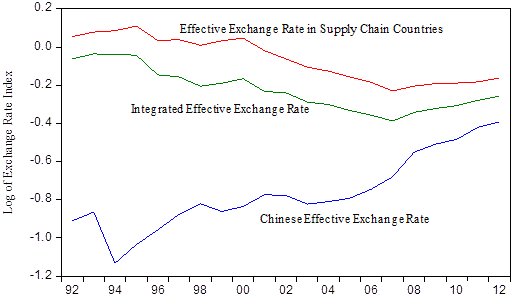| Author Name | THORBECKE, Willem (Senior Fellow, RIETI) |
|---|---|
| Research Project | East Asian Production Networks and Global Imbalances |
| Download / Links |
This Non Technical Summary does not constitute part of the above-captioned Discussion Paper but has been prepared for the purpose of providing a bold outline of the paper, based on findings from the analysis for the paper and focusing primarily on their implications for policy. For details of the analysis, read the captioned Discussion Paper. Views expressed in this Non Technical Summary are solely those of the individual author(s), and do not necessarily represent the views of the Research Institute of Economy, Trade and Industry (RIETI).
International Macroeconomics Program (FY2011-FY2015)
East Asian Production Network and Global Imbalances Project
Since 2005, China has run large surpluses in a customs regime called processing trade. Processed exports are final goods such as computers produced using parts and components (imports for processing) that are imported duty free. In 2012, China's surplus in processing trade exceeded $400 billion.
China's surpluses in processing trade are primarily with Western countries, and it runs deficits with South Korea, Taiwan, and other East Asian economies that provide the lion's share of the imported inputs. Since much of the value added of processed exports such as smartphones and tablet personal computers (PCs) comes from parts and components imported from East Asian countries, the region as a whole and not just China runs surpluses with Western countries. These surpluses put pressure on exchange rates throughout the supply chain to appreciate.
Using data up to 2012, this paper reports that a concerted appreciation in East Asia would reduce processed exports, increase imports for processing, and rebalance processing trade. An appreciation in China accompanied by depreciations in other surplus economies such as Taiwan and South Korea would not reduce China's surplus in processing trade but would increase its deficit in ordinary (labor-intensive) trade.
Figure 2 below shows that China's appreciation has been offset by depreciations in supply chain countries. The figure presents the real effective exchange rates (REER) for China's processed exports. These exchange rates are weighted averages of the bilateral exchange rates for the 24 countries employed in the paper, with weights determined by the share of processed exports going to each of the countries. By this measure, China's REER has appreciated by 39% between 2002 and 2012. However, the REER in supply chain countries has depreciated by 10% over the same period. As a result, the integrated REER that affects processed exports essentially has the same value in 2012 that it had in 2002. The appreciation of China's REER reduced the growth of China's labor-intensive (ordinary) exports. The offsetting depreciation in supply chain countries, however, implies that China's processed exports were not affected by the renminbi appreciation.
These results imply that domestic policymakers and international organizations such as the International Monetary Fund (IMF) and the Association of Southeast Asian Nations (ASEAN) +3 Macroeconomic Research Office (AMRO) should conduct surveillance, not only at the national level but also at the level of regional supply chains. If China has a large current account surplus, they might recommend an appreciation of the renminbi. However, if the appreciation of the renminbi is offset by depreciations in other supply chain countries as is evident in Figure 2, the source of China's surplus (processing trade) will not be affected, but low margin labor-intensive trade will fall further into deficit. When making recommendations for China's trade surplus and its exchange rate, it is thus necessary to take account of exchange rates throughout the region.
Figure 2: Real Effective Exchange Rate for China, Supply Chain Countries, and China and Supply Chain Countries Together Relative to Countries Importing China's Processed Exports

Note: The effective exchange rates are weighted average exchange rates calculated based on China's processed exports to 24 leading importers.
Source: China Customs Statistics, CEPII-CHELEM Database, and author's calculations

